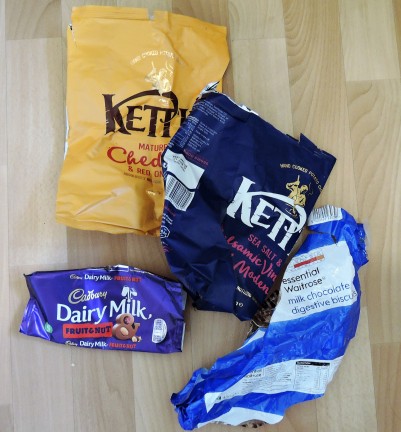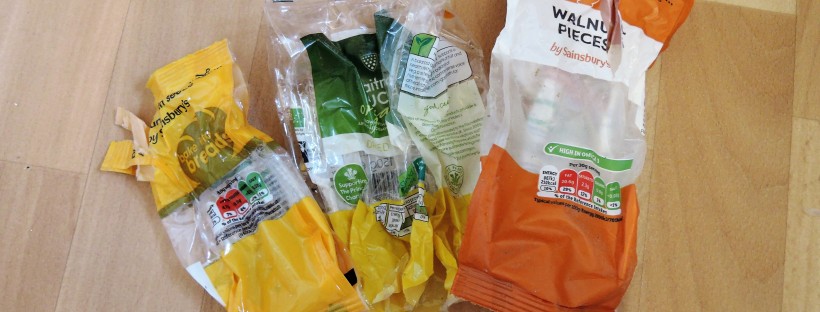I’ve got something unusual to share with you today, my garbage! Exciting, right? But seriously, do you actually know what you send to landfill every month?
A garbage audit (commonly known as a trash audit in the zero waste community) is when you sift through your bin to take inventory of the items you intend to send to landfill. Whatever you call it, one of the most powerful things you can do is critically evaluate your waste.
Just as Marie Kondo recommends piling all your clothes to sort through them (see my post on minimalism), it’s beneficial to do the same with your garbage. Once it goes into that bin bag, your waste is out of sight, out of mind.
While I don’t think it’s realistic for all of us to aspire to keep our minimal waste in a glass jar (like Bea Johnson), I do think we can examine and re-think our waste. Every person’s situation will be different in terms of lifestyle and your area’s landfill waste/food waste/recycling collection, but I guarantee that every one of us can make some changes.

Photo by mariagranel.lx
In the UK, the Department for Environment Food & Rural Affairs waste report from March 2019 states that the household recycling rate was 45.7% in 2017, and positively, the rate of food waste going to landfill is declining. 70% of packaging was recycled. However, a lot of the UK’s recycling is exported where it can be dumped or burned, and the recycling system is generally problematic (see Ocean Rescue documentary for details). In 2016, the UK generated nearly 223 million tonnes of waste, 27 of which was household.
Statistics Canada notes that 25 million tonnes of non-hazardous waste were produced in 2016, with 41% being from households. In 2012, Canadians produced more waste per capita than any other developed country (I hope these stats have changed since the introduction of food and garden waste pick up). Much of the waste Canada makes ends up in landfills or is dumped in the oceans. They also ship their waste to the US. I couldn’t find comparable statistics for America, but the EPA reported that in 2015 that Americans made 262 million tonnes of garbage and 4.5 pounds of garbage per person per day.
My workplace recently had a garbage audit and found that 50% of the rubbish was recyclable and a large proportion was food waste. We now have food waste bins, and students and staff are trying to reduce waste where possible. They’ve started a sustainability working group and send out monthly newsletters. In many cases it isn’t ignorance that prevents people from disposing of waste more sustainably, it’s bad habits and lack of conscious effort.
At home, we recycle religiously and we have a food waste container, but I still wanted to look at our garbage to pinpoint areas for improvement. We take out our food container once a week and recycling goes out around twice a week. It’s becoming increasingly apparent that recycling is not the solution. Although we try to choose cardboard, glass, and tin cans where possible to minimise plastic, ideally we want to reduce the recycling overall.

As with all topics relating to sustainability, it’s about finding the balance of having things you enjoy, keeping consumption within your financial budget, and reducing waste. For example, I like snack foods but these come in non-recyclable packaging. I need to really crave those m&ms before I will actively choose to buy a packaged product that isn’t recyclable, fair trade, has a huge carbon footprint, and isn’t healthy.
Questions to ask yourself about your garbage
- Can you buy less, or do without?
- Do you recycle?
- Are there single-use items that you could live without? E.g. single-use drinks, snacks, ready meals and fast food.
- Can you purchase the same product in recyclable packaging, or better yet, bought in bulk?
- Can you compost or use a food waste bin?
- Can you prepare, serve, and store your food in a different way? E.g. no cling film, paper plates, lining cooking trays
- Can you dispose of your garbage differently (frequency, type of bag)?
- Can you switch to reusable menstrual products or cloth diapers/nappies for your babies?
- Can you use hankies and cloths instead of tissues and paper towel (or wet wipes)?
What was in my bin?
From the end of December to mid February we produced one bag of garbage. We try to not take out the garbage so one bag can last a couple of months. You may produce less, or much more. Each household is unique, so don’t assume that this is a good benchmark for you.
Our main categories of waste:
- Vacuum dirt. We have a Dyson so we don’t have a bag for the vacuum. We simply dump the lint etc. into the garbage. This could theoretically go in a compost pile, but then you run the risk of synthetic fibres and chemicals going into the soil.
- Packets
- Tin foil with oil on it (only clean can be recycled)
- Stickers from produce. Waitrose tends to not have stickers on their produce if it is the only variety in the shop that is loose. Still, there are fairtrade stickers on bananas, and stickers on varieties of apples and oranges.
- Tortilla wrap packages. I take a wrap most days for lunch. We try to buy loose bread or make bread. Some bread and bagel bags can be recycled at the supermarket, while the wrap bags cannot. Same goes for pitas, crumpets, naans etc.
- Generic plastic packaging
- Bags from frozen food like peas and corn.

- Film from produce that you can’t buy loose like berries and grapes
- Junk food packaging
- Cereal inner bag
- Asian noodle packages
- Tofu package
- Dried fruits, seeds, and nuts packaging (It’s currently too expensive for our budget to buy in bulk locally because they stock organic which is more than 10x the price.)
- Rice cakes (2 packs a month)
- Cheese (1 pack every 2 weeks approx.)
- Packaging for essential veg that doesn’t come loose in the UK (cucumber, lettuce, cauliflower, celery)
- Greeting card wrappers. It’s very difficult to find loose cards for birthdays in most shops.
- Labels- even the bulk food shop we go to has scale labels for the product type and weight.

- Fresh herbs. It annoys me so much that we can’t buy loose herbs in the UK. Until I can grow a herb garden, I buy my herbs dry, I have a basil and mint plants, and when I do buy fresh herbs, I freeze the rest to avoid food waste.
- Toilet roll packaging. Even though we buy recycled paper, it comes in plastic packaging. Who Gives a Crap? is a plastic free toilet paper delivery service, but they are too pricy for our budget.
- Shipping packaging
My goals
- Stop making my weekly baked (jacket) potatoes in foil. I now use our glass lidded baking dish and that is one less piece of foil going into the garbage every week.
- Limit baking where I use a lot of icing. I’ve mentioned in a previous post about disposable piping bags, excess icing that ends up as food waste, and a heavy use of dairy.
- Limit packaged snacks; they aren’t good for me anyways. I now buy one bar of paper and foil wrapped ethical (fairtrade) chocolate for my snack every week. Sometimes I cave and buy crisps; nobody’s perfect.
- Shipping packaging is a difficult one. I try not to buy a lot. On Etsy, I request for items to be shipped in recycled or plastic free packaging, which usually works. When I buy second hand books on Amazon, sometimes these come in cardboard, other times they come in plastic. Win some lose some.

The waste you see isn’t the only waste
A home garbage audit only looks at post-consumer waste. In other words, the waste you make with packaging, food, and products when you’re done with them. It’s equally worth considering the resource and manufacturing waste of your consumables.
- Where are your items grown or produced? If it is a product, it’s possible that it’s produced in stages in more than one location.
- Is the item resource heavy to grow or produce? Also consider things like petroleum products, paper resources, and palm oil.
- Is it in season? Try to buy fresh produce that is locally produced to avoid high resource consumption and shipping.
- Is it chemical free? Chemicals in the manufacturing process have a huge environmental impact. Produce grown with pesticides is also something to consider.
- Is it sourced sustainably? Is there a lot of waste in production, or, like fishing and cattle farming, does it have a huge environmental impact?
- Is it ethical? Was your garment made in a factory which uses unethical labour? Are you shopping at a store that doesn’t treat its employees well and pays them a non-living wage? I class this as waste because it is a waste of the quality of life for others.
- Shelf life – food waste is a huge problem. Consider the quantities you need, and if it’s better to buy fresh or frozen.
Companies carry an equal responsibility to reduce their packaging and limit the resources used in production/cultivation. The companies and your government must be held accountable. Write to your shops and the brands you support and ask about their sustainability goals. Encourage them to make changes for the environment. Make your voice heard in regards to treatment of workers. Vote with your money.
I encourage you to do a garbage audit, just mind the sharps and wear gloves! If you do, please share one item that you’re going to swap for a sustainable option, or go without, to reduce your waste.
If you’re just starting to make changes, what is one item you will remember to recycle or add to your food waste bin this week?
Happy auditing!


I have done this! My garbage was similar to yours 🙂 Plus cat litter.
LikeLiked by 1 person
Great article! Would you be interested in collaborating?
LikeLiked by 1 person
Sure, always happy to collaborate!
LikeLike